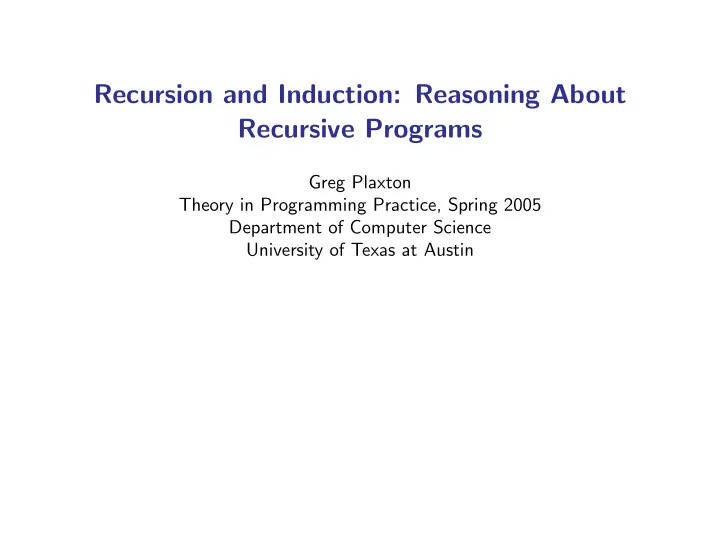

Recursion and Induction: Reasoning About Recursive Programs Greg Plaxton Theory in Programming Practice, Spring 2005 Department of Computer Science University of Texas at Austin
Proving Properties of power2 • Recall the recursive program power2 presented last time power2 0 = 1 power2 (n+1) = 2 * (power2 n) • Claim: For all nonnegative integers n , the value of the power2 function applied to n is 2 n • While this claim may seem relatively obvious, how can we formally prove it? Theory in Programming Practice, Plaxton, Spring 2005
Proving Properties of count • Recall the recursive program count we presented last time count 0 = 0 count n | even n = count (n ‘div‘ 2) | odd n = count (n ‘div‘ 2) + 1 • For any nonnegative integer n , let C ( n ) denote the value returned by the count function applied to argument n • Claim 1: For all nonnegative integers n , C ( n ) equals the number of 1s in the binary representation of n Theory in Programming Practice, Plaxton, Spring 2005
Proving Properties of count • Claim 2: For all nonnegative integers m and n , C ( m + n ) ≤ C ( m ) + C ( n ) • Hint: Use induction over pairs ( m, n ) (ordered lexicographically, say), and consider cases depending on the parity of m and n Theory in Programming Practice, Plaxton, Spring 2005
Proving Properties of fib • Recall the recursive program we presented last time for computing the Fibonacci numbers fib 0 = 0 fib 1 = 1 fib (n + 2) = (fib n) + (fib (n+1)) • For any nonnegative integer n , let F ( n ) denote the value returned by the fib function applied to argument n • Claim: For all integers m and n such that m > 0 and n ≥ 0 F ( m + n ) = F ( m − 1) · F ( n ) + F ( m ) · F ( n + 1) – Hint: Fix m arbitrarily and use induction on n alone Theory in Programming Practice, Plaxton, Spring 2005
Proving Properties of fib and gcd • Recall Euclid’s gcd algorithm gcd m n | m == n = m | m > n = gcd (m - n) n | n > m = gcd m (n - m) • For any nonnegative integers m and n , let g ( m, n ) denote the value returned by the gcd function applied to arguments m and n • Claim: For all positive integers n g ( F ( n ) , F ( n + 1)) = 1 Theory in Programming Practice, Plaxton, Spring 2005
Recommend
More recommend